What force is powerful enough to move plates on Earths Surface?
Critique and interpret major types of evidence supporting the Theory of Plate Tectonics.
Plate tectonics is the nigh important concept in modern geology. This section will introduce you to the concept of plate tectonics, how it works, why it is important and how it is shaping the world today.
What You'll Larn to Do
- Describe and compare different types of plate motions, rates of motility and the driving mechanisms and forces involved with each.
- Know the office of applied science in Plate Tectonics.
Theory of Plate Tectonics
When the concept of seafloor spreading came along, scientists recognized that it was the machinery to explain how continents could move effectually Earth's surface. Like the scientists before united states, we will now merge the ideas of continental drift and seafloor spreading into the theory of plate tectonics.
Watch this video almost continental drift and the mechanism of seafloor spreading create plate tectonics.
Globe's Tectonic Plates
Seafloor and continents movement around on Globe's surface, simply what is actually moving? What portion of the Earth makes up the "plates" in plate tectonics? This question was also answered because of technology adult during war times – in this example, the Cold War. The plates are made up of the lithosphere.
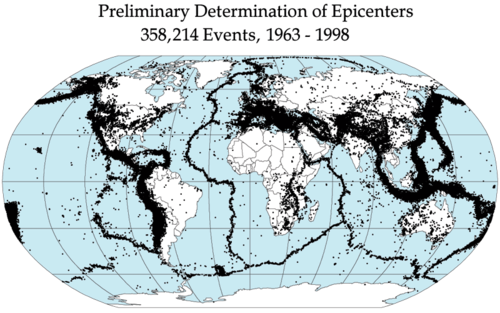
Effigy one. Earthquakes outline the plates.
During the 1950s and early on 1960s, scientists set up upwards seismograph networks to see if enemy nations were testing atomic bombs. These seismographs as well recorded all of the earthquakes around the planet. The seismic records could be used to locate an earthquake's epicenter, the point on Globe's surface directly above the identify where the earthquake occurs.
Earthquake epicenters outline the plates. Mid-ocean ridges, trenches, and large faults marking the edges of the plates, and this is where earthquakes occur (figure i).
The lithosphere is divided into a dozen major and several minor plates (figure 2). The plates' edges can be drawn by connecting the dots that mark earthquakes' epicenters. A single plate can be made of all oceanic lithosphere or all continental lithosphere, just nearly all plates are made of a combination of both.
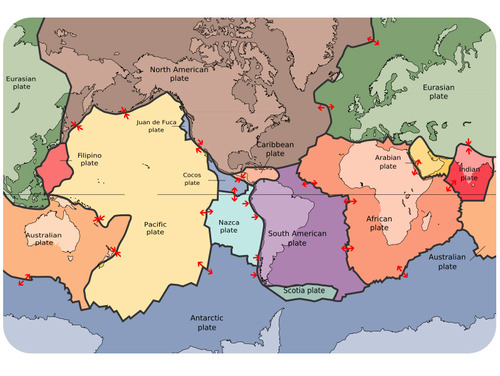
Figure 2. The lithospheric plates and their names. The arrows show whether the plates are moving autonomously, moving together, or sliding past each other.
Movement of the plates over Globe'due south surface is termed plate tectonics. Plates movement at a charge per unit of a few centimeters a year, about the same charge per unit fingernails abound.
How Plates Movement
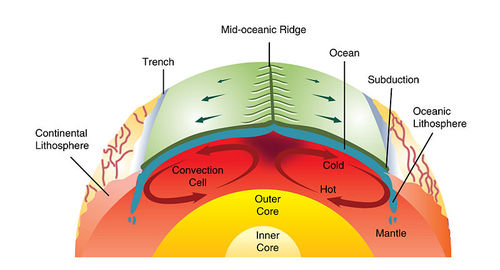
Figure 3. Drapery convection drives plate tectonics. Hot cloth rises at mid-body of water ridges and sinks at deep sea trenches, which keeps the plates moving along the Earth's surface.
If seafloor spreading drives the plates, what drives seafloor spreading? Film two convection cells side-by-side in the mantle, similar to the illustration in figure three.
- Hot mantle from the two adjacent cells rises at the ridge centrality, creating new ocean crust.
- The top limb of the convection prison cell moves horizontally away from the ridge crest, equally does the new seafloor.
- The outer limbs of the convection cells plunge down into the deeper mantle, dragging oceanic chaff as well. This takes identify at the deep ocean trenches.
- The textile sinks to the core and moves horizontally.
- The material heats upward and reaches the zone where it rises again.
Bank check out this blitheness of curtain convection and watch this video:
Plate Boundaries
Plate boundaries are the edges where two plates meet. Most geologic activities, including volcanoes, earthquakes, and mountain building, accept place at plate boundaries. How tin can two plates move relative to each other?
- Divergent plate boundaries: the ii plates motion away from each other.
- Convergent plate boundaries: the 2 plates move towards each other.
- Transform plate boundaries: the two plates skid past each other.
The type of plate boundary and the type of chaff found on each side of the purlieus determines what sort of geologic action will exist plant there.
Divergent Plate Boundaries
Plates motion autonomously at mid-ocean ridges where new seafloor forms. Betwixt the two plates is a rift valley. Lava flows at the surface cool rapidly to become basalt, but deeper in the crust, magma cools more slowly to grade gabbro. Then the entire ridge system is made upward of igneous rock that is either extrusive or intrusive. Earthquakes are common at mid-ocean ridges since the movement of magma and oceanic crust results in crustal shaking. The vast bulk of mid-ocean ridges are located deep below the sea (figure 4).
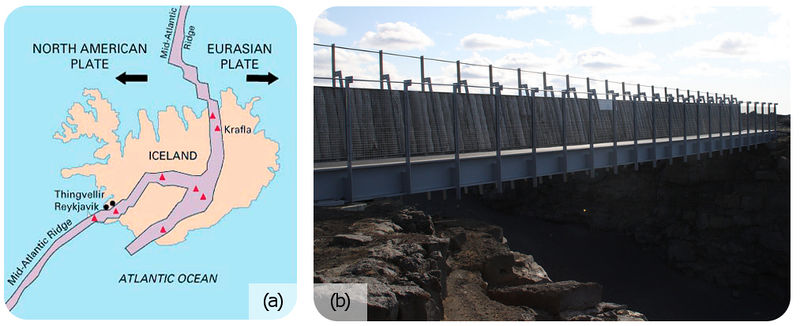
Figure iv. (a) Republic of iceland is the i location where the ridge is located on land: the Mid-Atlantic Ridge separates the North American and Eurasian plates; (b) The rift valley in the Mid-Atlantic Ridge on Iceland.
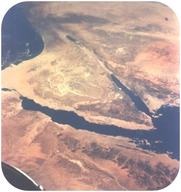
Effigy 5. The Arabian, Indian, and African plates are rifting autonomously, forming the Dandy Rift Valley in Africa. The Dead Sea fills the rift with seawater.
Check out these animations:
- Divergent plate boundary at mid-ocean ridge
- Divergent plate boundary
Tin divergent plate boundaries occur within a continent? What is the result? Incontinental rifting (effigy 5), magma rises below the continent, causing information technology to go thinner, break, and ultimately split apart. New sea chaff erupts in the void, creating an ocean between continents.
Convergent Plate Boundaries
When two plates converge, the result depends on the type of lithosphere the plates are made of. No matter what, keen two enormous slabs of lithosphere together results in magma generation and earthquakes.
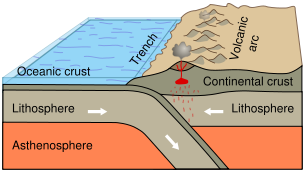
Figure six. Subduction of an oceanic plate below a continental plate causes earthquakes and forms a line of volcanoes known every bit a continental arc.
Ocean-Continent
When oceanic chaff converges with continental crust, the denser oceanic plate plunges beneath the continental plate. This process, chosen subduction, occurs at the oceanic trenches (effigy half-dozen). The entire region is known every bit a subduction zone. Subduction zones accept a lot of intense earthquakes and volcanic eruptions. The subducting plate causes melting in the pall. The magma rises and erupts, creating volcanoes. These littoral volcanic mountains are found in a line to a higher place the subducting plate (figure 7). The volcanoes are known as a continental arc.
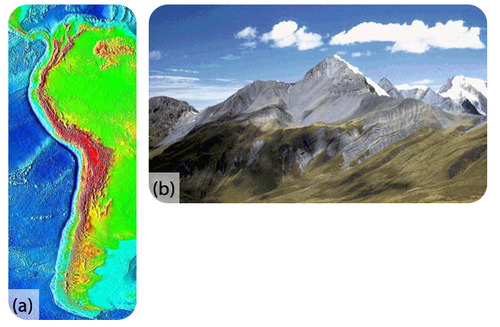
Figure 7. (a) At the trench lining the western margin of Southward America, the Nazca plate is subducting below the South American plate, resulting in the Andes Mountains (chocolate-brown and ruddy uplands); (b) Convergence has pushed upwards limestone in the Andes Mountains where volcanoes are common.
The movement of chaff and magma causes earthquakes. Wait at this map of earthquake epicenters at subduction zones. This blitheness shows the relationship between subduction of the lithosphere and creation of a volcanic arc.
The volcanoes of northeastern California—Lassen Peak, Mount Shasta, and Medicine Lake volcano—along with the residuum of the Cascade Mountains of the Pacific Northwest are the upshot of subduction of the Juan de Fuca plate beneath the North American plate (figure 8). The Juan de Fuca plate is created by seafloor spreading only offshore at the Juan de Fuca ridge.
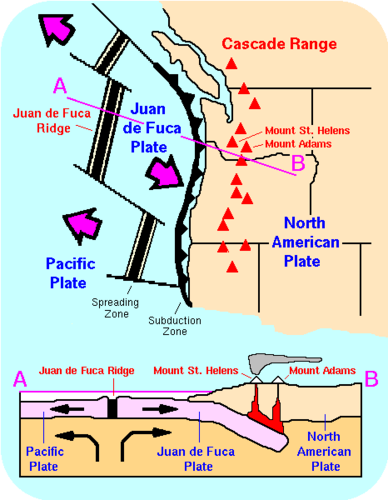
Effigy eight. The Cascade Mountains of the Pacific Northwest are a continental arc.
If the magma at a continental arc is felsic, it may exist likewise viscid (thick) to rise through the crust. The magma volition cool slowly to class granite or granodiorite. These large bodies of intrusive igneous rocks are called batholiths, which may someday be uplifted to form a mountain range (figure 9).
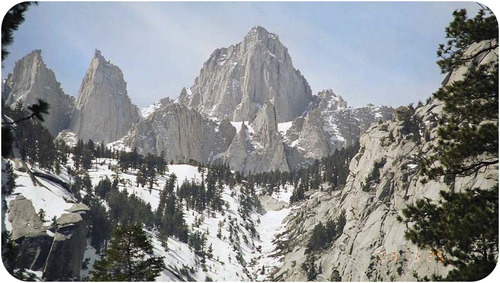
Figure ix. The Sierra Nevada batholith cooled beneath a volcanic arc roughly 200 million years ago. The rock is well exposed here at Mount Whitney. Like batholiths are likely forming beneath the Andes and Cascades today.
Ocean-Ocean
When two oceanic plates converge, the older, denser plate will subduct into the curtain. An ocean trench marks the location where the plate is pushed down into the mantle. The line of volcanoes that grows on the upper oceanic plate is an isle arc. Do you lot recall earthquakes are mutual in these regions (figure x)?
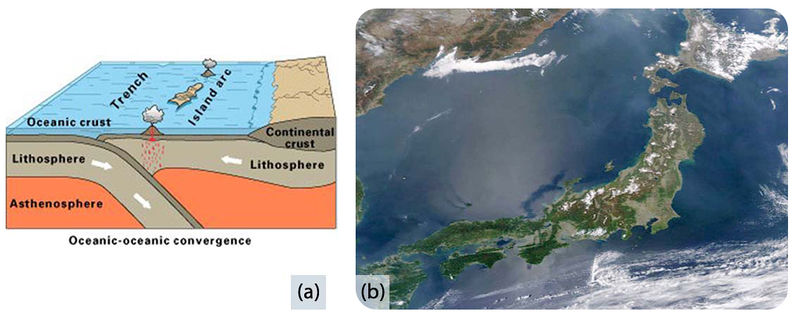
Figure ten. (a) Subduction of an body of water plate beneath an ocean plate results in a volcanic island arc, an body of water trench and many earthquakes. (b) Japan is an arc-shaped island arc equanimous of volcanoes off the Asian mainland, as seen in this satellite image.
Cheque out this animation of an sea continent plate purlieus.
Continent-Continent
Continental plates are besides buoyant to subduct. What happens to continental material when it collides? Since it has nowhere to become merely up, this creates some of the world'due south largest mountains ranges (figure 11). Magma cannot penetrate this thick crust and then there are no volcanoes, although the magma stays in the crust. Metamorphic rocks are common because of the stress the continental crust experiences. With enormous slabs of crust swell together, continent-continent collisions bring on numerous and large earthquakes.
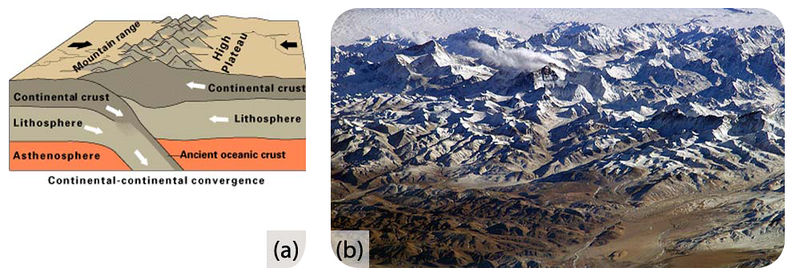
Figure 11. (a) In continent-continent convergence, the plates push upward to create a high mountain range. (b) The world's highest mountains, the Himalayas, are the effect of the collision of the Indian Plate with the Eurasian Plate, seen in this photograph from the International Space Station.
Check out this short animation of the Indian Plate colliding with the Eurasian Plate.
Watch this blitheness of the Himalaya rising.
The Appalachian Mountains are the remnants of a large mountain range that was created when Northward America rammed into Eurasia about 250 meg years agone.
Transform Plate Boundaries
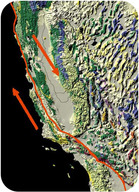
Figure 12. At the San Andreas Mistake in California, the Pacific Plate is sliding northwest relative to the North American plate, which is moving southeast. At the northern end of the picture, the transform boundary turns into a subduction zone.
Transform plate boundaries are seen equally transform faults, where two plates move past each other in reverse directions. Transform faults on continents bring massive earthquakes (figure 12).
California is very geologically agile. What are the three major plate boundaries in or well-nigh California (effigy thirteen)?
- A transform plate boundary betwixt the Pacific and North American plates creates the San Andreas Fault, the world's most notorious transform fault.
- Only offshore, a divergent plate boundary, Juan de Fuca ridge, creates the Juan de Fuca plate.
- A convergent plate boundary betwixt the Juan de Fuca oceanic plate and the North American continental plate creates the Cascades volcanoes.
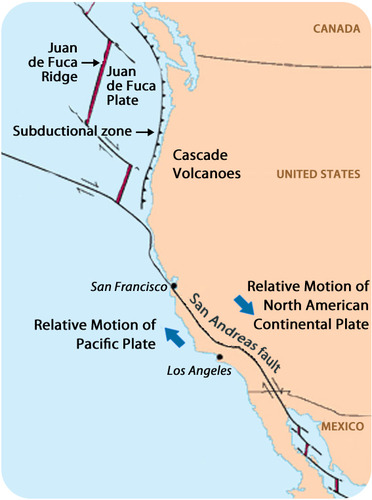
Figure thirteen. This map shows the three major plate boundaries in or near California.
A brief review of the three types of plate boundaries and the structures that are found there is the field of study of this wordless video.
Earth'due south Changing Surface
Geologists know that Wegener was right considering the movements of continents explain so much most the geology we encounter. Most of the geologic activeness that we see on the planet today is because of the interactions of the moving plates.
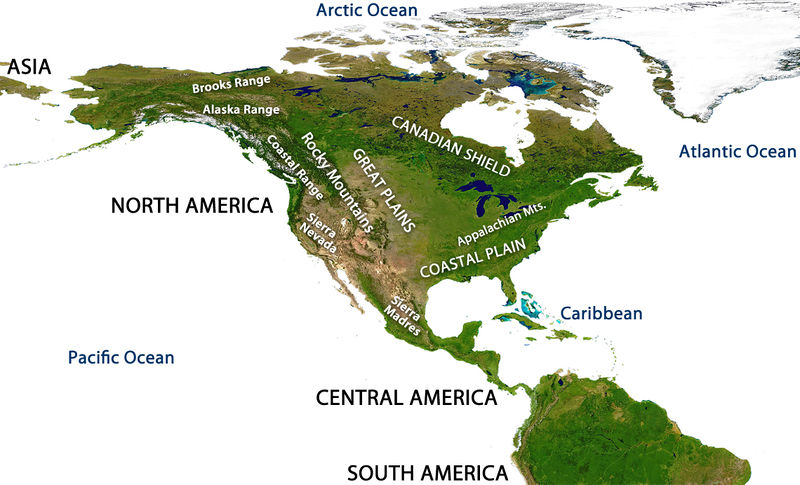
Effigy fourteen. Mountain ranges of North America.
In the map of North America (effigy 14), where are the mountain ranges located? Using what y'all accept learned about plate tectonics, try to answer the following questions:
- What is the geologic origin of the Cascades Range? The Cascades are a chain of volcanoes in the Pacific Northwest. They are not labelled on the diagram merely they lie between the Sierra Nevada and the Coastal Range.
- What is the geologic origin of the Sierra Nevada? (Hint: These mountains are made of granitic intrusions.)
- What is the geologic origin of the Appalachian Mountains along the Eastern Usa?
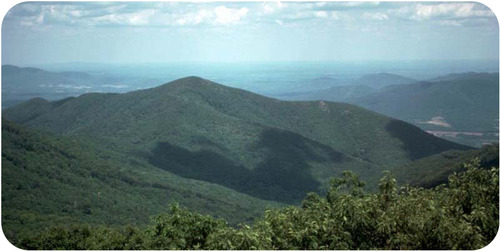
Effigy 15. About 200 million years ago, the Appalachian Mountains of eastern Due north America were probably once equally high as the Himalaya, but they have been weathered and eroded significantly since the breakdown of Pangaea.
Call up that Wegener used the similarity of the mountains on the west and east sides of the Atlantic as evidence for his continental migrate hypothesis. The Appalachian mountains formed at a convergent plate boundary equally Pangaea came together (figure 15).
Earlier Pangaea came together, the continents were separated by an bounding main where the Atlantic is now. The proto-Atlantic bounding main shrank as the Pacific ocean grew. Currently, the Pacific is shrinking as the Atlantic is growing. Thissupercontinent cycle is responsible for near of the geologic features that we encounter and many more than that are long gone (figure 16).

Figure 16. Scientists think that the cosmos and breakup of a supercontinent takes place about every 500 million years. The supercontinent before Pangaea was Rodinia. A new continent will form as the Pacific ocean disappears.
This animation shows the movement of continents over the past 600 million years beginning with the breakup of Rodinia.
Summary
- Plates of lithosphere move because of convection currents in the curtain. 1 type of motion is produced by seafloor spreading.
- Plate boundaries tin can be located by outlining convulsion epicenters.
- Plates interact at three types of plate boundaries: divergent, convergent and transform.
- Most of the Earth'southward geologic activity takes place at plate boundaries.
- At a divergent purlieus, volcanic activity produces a mid bounding main ridge and small earthquakes.
- At a convergent boundary with at least 1 oceanic plate, an ocean trench, a chain of volcanoes develops and many earthquakes occur.
- At a convergent boundary where both plates are continental, mountain ranges grow and earthquakes are common.
- At a transform purlieus, there is a transform fault and massive earthquakes occur but there are no volcanoes.
- Processes acting over long periods of time create Globe'southward geographic features.
Developing the Theory
In line with other previous and contemporaneous proposals, in 1912 the meteorologist Alfred Wegener amply described what he chosen continental drift, expanded in his 1915 book The Origin of Continents and Oceans [one], and the scientific debate started that would end up l years later in the theory of plate tectonics. Starting from the idea (also expressed by his forerunners) that the present continents in one case formed a single land mass (which was called Pangea after) that drifted apart, thus releasing the continents from the World's mantle and likening them to "icebergs" of low density granite floating on a body of water of denser basalt.
Supporting show for the idea came from the dove-tailing outlines of South America'south east coast and Africa'southward due west coast, and from the matching of the stone formations forth these edges. Confirmation of their previous contiguous nature besides came from the fossil plants Glossopteris andGangamopteris, and the therapsid or mammal-like reptile Lystrosaurus, all widely distributed over S America, Africa, Antarctica, India and Australia. The evidence for such an erstwhile joining of these continents was patent to field geologists working in the southern hemisphere. The S African Alex du Toit put together a mass of such information in his 1937 publication Our Wandering Continents, and went farther than Wegener in recognising the strong links between the Gondwana fragments.
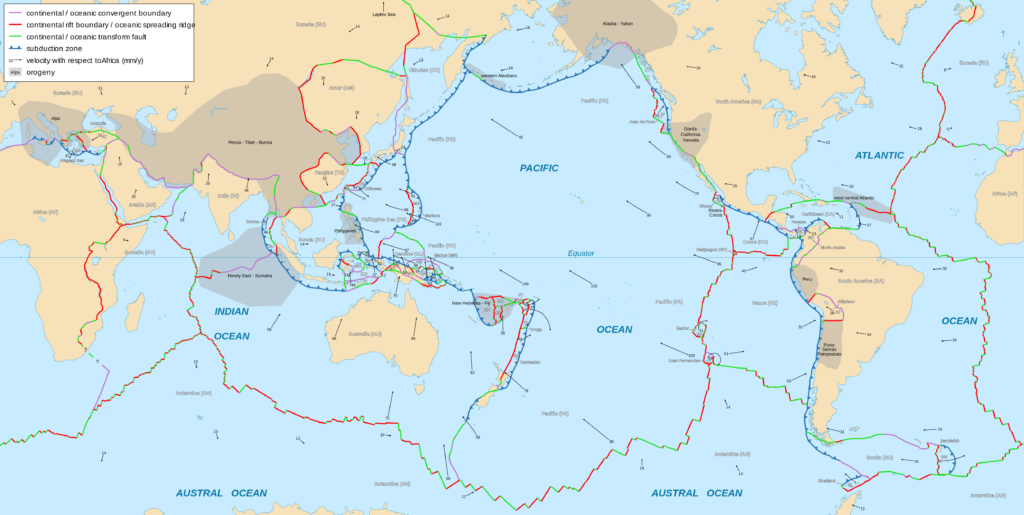
Figure 17. Detailed map showing the tectonic plates with their motility vectors. (Click on the image to open a larger version of the map.)
Only without detailed evidence and a force sufficient to drive the movement, the theory was not generally accepted: the Earth might have a solid crust and curtain and a liquid core, but there seemed to be no way that portions of the crust could movement around. Distinguished scientists, such as Harold Jeffreys and Charles Schuchert, were outspoken critics of continental drift.
Despite much opposition, the view of continental drift gained support and a lively debate started between "drifters" or "mobilists" (proponents of the theory) and "fixists" (opponents). During the 1920s, 1930s and 1940s, the former reached important milestones proposing that convection currents might accept driven the plate movements, and that spreading may have occurred beneath the sea within the oceanic crust. Concepts close to the elements now incorporated in plate tectonics were proposed by geophysicists and geologists (both fixists and mobilists) like Vening-Meinesz, Holmes, and Umbgrove.
Ane of the first pieces of geophysical evidence that was used to support the movement of lithospheric plates came from paleomagnetism. This is based on the fact that rocks of different ages show a variable magnetic field direction, evidenced by studies since the mid–nineteenth century. The magnetic due north and south poles reverse through time, and, peculiarly important in paleotectonic studies, the relative position of the magnetic due north pole varies through time. Initially, during the first one-half of the twentieth century, the latter phenomenon was explained by introducing what was called "polar wander" (see apparent polar wander), i.east., it was assumed that the north pole location had been shifting through time. An culling explanation, though, was that the continents had moved (shifted and rotated) relative to the northward pole, and each continent, in fact, shows its own "polar wander path". During the belatedly 1950s it was successfully shown on ii occasions that these data could show the validity of continental migrate: by Keith Runcorn in a newspaper in 1956,[2] and past Warren Carey in a symposium held in March 1956.[iii]
The second piece of prove in support of continental migrate came during the late 1950s and early 60s from data on the bathymetry of the deep body of water floors and the nature of the oceanic crust such as magnetic properties and, more generally, with the development of marine geology which gave show for the association of seafloor spreading along the mid-oceanic ridges and magnetic field reversals, published between 1959 and 1963 by Heezen, Dietz, Hess, Mason, Vine & Matthews, and Morley.
Simultaneous advances in early seismic imaging techniques in and around Wadati-Benioff zones along the trenches bounding many continental margins, together with many other geophysical (due east.g. gravimetric) and geological observations, showed how the oceanic chaff could disappear into the curtain, providing the mechanism to remainder the extension of the bounding main basins with shortening forth its margins.
All this evidence, both from the ocean floor and from the continental margins, fabricated it clear around 1965 that continental drift was feasible and the theory of plate tectonics, which was defined in a series of papers betwixt 1965 and 1967, was born, with all its extraordinary explanatory and predictive power. The theory revolutionized the Earth sciences, explaining a diverse range of geological phenomena and their implications in other studies such every bit paleogeography and paleobiology.
Continental Drift
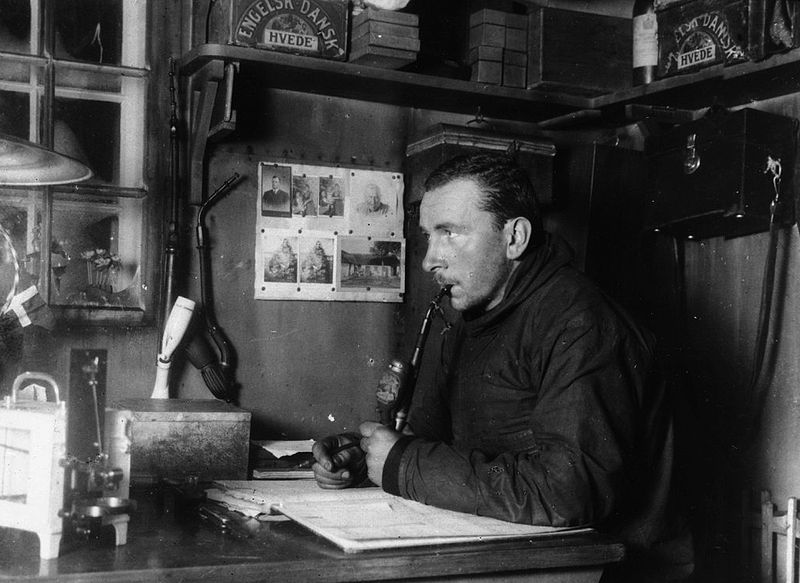
Figure eighteen. Alfred Wegener in Greenland in the winter of 1912-13.
In the tardily nineteenth and early on twentieth centuries, geologists assumed that the World's major features were fixed, and that most geologic features such as basin development and mountain ranges could be explained by vertical crustal motion, described in what is called the geosynclinal theory. More often than not, this was placed in the context of a contracting planet Earth due to heat loss in the class of a relatively short geological fourth dimension.
It was observed as early as 1596 that the opposite coasts of the Atlantic Sea—or, more precisely, the edges of the continental shelves—have similar shapes and seem to take once fitted together.
Since that time many theories were proposed to explain this apparent complementarity, but the assumption of a solid Earth made these various proposals difficult to accept.[
The discovery of radioactive decay and its associated heating backdrop in 1895 prompted a re-exam of the apparent age of the Earth. This had previously been estimated by its cooling rate and assumption the Earth'due south surface radiated like a black body. Those calculations had unsaid that, even if information technology started at red rut, the Earth would take dropped to its present temperature in a few tens of millions of years. Armed with the knowledge of a new heat source, scientists realized that the Globe would be much older, and that its core was still sufficiently hot to be liquid.
Past 1915, later on having published a first article in 1912, Alfred Wegener was making serious arguments for the idea of continental drift in the commencement edition of The Origin of Continents and Oceans. In that volume (re-issued in four successive editions upwards to the final ane in 1936), he noted how the east coast of South America and the west coast of Africa looked every bit if they were one time attached. Wegener was not the first to note this (Abraham Ortelius, Antonio Snider-Pellegrini, Eduard Suess, Roberto Mantovani and Frank Bursley Taylor preceded him simply to mention a few), simply he was the beginning to marshal pregnant fossil and paleo-topographical and climatological evidence to support this simple observation (and was supported in this past researchers such as Alex du Toit). Furthermore, when the rock strata of the margins of divide continents are very like it suggests that these rocks were formed in the same way, implying that they were joined initially. For case, parts of Scotland and Ireland contain rocks very similar to those establish in Newfoundland and New Brunswick. Furthermore, the Caledonian Mountains of Europe and parts of the Appalachian Mountainsof North America are very similar in construction and lithology.
However, his ideas were not taken seriously past many geologists, who pointed out that there was no credible mechanism for continental migrate. Specifically, they did not run across how continental rock could plow through the much denser rock that makes up oceanic crust. Wegener could not explain the force that collection continental drift, and his vindication did not come until after his expiry in 1930.
Floating Continents, Paleomagnetism, and Seismicity Zones
As it was observed early that although granite existed on continents, seafloor seemed to exist equanimous of denser basalt, the prevailing concept during the outset half of the twentieth century was that there were two types of crust, named "sial" (continental type crust) and "sima" (oceanic type crust). Furthermore, it was supposed that a static shell of strata was nowadays under the continents. Information technology therefore looked apparent that a layer of basalt (sial) underlies the continental rocks.
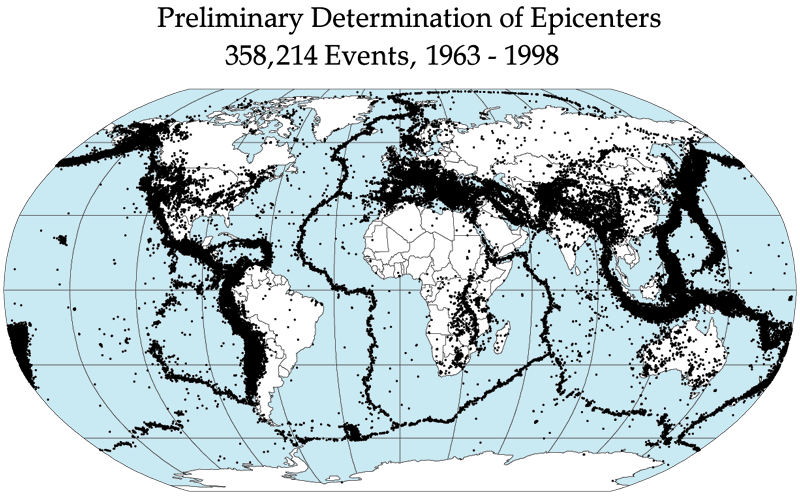
Figure nineteen. Global earthquake epicenters, 1963–1998
However, based on abnormalities in plumb line deflection past the Andes in Peru, Pierre Bouguer had deduced that less-dense mountains must have a downward projection into the denser layer underneath. The concept that mountains had "roots" was confirmed by George B. Airy a hundred years later, during study of Himalayan gravitation, and seismic studies detected corresponding density variations. Therefore, past the mid-1950s, the question remained unresolved as to whether mountain roots were clenched in surrounding basalt or were floating on information technology like an iceberg.
During the 20th century, improvements in and greater use of seismic instruments such every bit seismographs enabled scientists to learn that earthquakes tend to be concentrated in specific areas, virtually notably along the oceanic trenches and spreading ridges. By the late 1920s, seismologists were first to place several prominent convulsion zones parallel to the trenches that typically were inclined 40–60° from the horizontal and extended several hundred kilometers into the Earth. These zones later became known as Wadati-Benioff zones, or simply Benioff zones, in honour of the seismologists who start recognized them, Kiyoo Wadati of Japan and Hugo Benioff of the Usa. The study of global seismicity greatly advanced in the 1960s with the establishment of the Worldwide Standardized Seismograph Network (WWSSN) to monitor the compliance of the 1963 treaty banning to a higher place-ground testing of nuclear weapons. The much improved information from the WWSSN instruments allowed seismologists to map precisely the zones of earthquake concentration worldwide.
Meanwhile, debates adult around the phenomena of polar wander. Since the early debates of continental drift, scientists had discussed and used testify that polar drift had occurred because continents seemed to have moved through dissimilar climatic zones during the past. Furthermore, paleomagnetic information had shown that the magnetic pole had also shifted during time. Reasoning in an opposite way, the continents might accept shifted and rotated, while the pole remained relatively fixed. The first time the evidence of magnetic polar wander was used to support the movements of continents was in a paper by Keith Runcorn in 1956, and successive papers past him and his students Ted Irving (who was really the beginning to exist convinced of the fact that paleomagnetism supported continental migrate) and Ken Creer.
This was immediately followed past a symposium in Tasmania in March 1956. In this symposium, the evidence was used in the theory of an expansion of the global crust. In this hypothesis the shifting of the continents tin can be just explained past a big increase in size of the Earth since its germination. Even so, this was unsatisfactory because its supporters could offering no convincing mechanism to produce a significant expansion of the Earth. Certainly at that place is no evidence that the moon has expanded in the past 3 billion years; other work would soon testify that the show was as in support of continental migrate on a globe with a stable radius.
During the thirties up to the late fifties, works past Vening-Meinesz, Holmes, Umbgrove, and numerous others outlined concepts that were close or nearly identical to modernistic plate tectonics theory. In item, the English geologist Arthur Holmes proposed in 1920 that plate junctions might lie beneath the sea, and in 1928 that convection currents within the mantle might be the driving force. Often, these contributions are forgotten considering:
- At the time, continental migrate was not accustomed.
- Some of these ideas were discussed in the context of abandoned fixistic ideas of a deforming globe without continental drift or an expanding Earth.
- They were published during an episode of farthermost political and economic instability that hampered scientific advice.
- Many were published by European scientists and at first not mentioned or given little credit in the papers on bounding main flooring spreading published by the American researchers in the 1960s.
Mid-Oceanic Ridge Spreading and Convection
In 1947, a team of scientists led past Maurice Ewing utilizing the Woods Hole Oceanographic Institution's inquiry vessel Atlantis and an array of instruments, confirmed the being of a rise in the cardinal Atlantic Ocean, and plant that the flooring of the seabed below the layer of sediments consisted of basalt, non the granite which is the main constituent of continents. They also found that the oceanic crust was much thinner than continental crust. All these new findings raised important and intriguing questions.
The new data that had been collected on the sea basins too showed particular characteristics regarding the bathymetry. I of the major outcomes of these datasets was that all along the earth, a arrangement of mid-oceanic ridges was detected. An important conclusion was that along this system, new ocean floor was being created, which led to the concept of the "Nifty Global Rift." This was described in the crucial paper of Bruce Heezen (1960),[4] which would trigger a existent revolution in thinking. A profound effect of seafloor spreading is that new chaff was, and nonetheless is, beingness continually created along the oceanic ridges. Therefore, Heezen advocated the and so-chosen "expanding Earth" hypothesis of S. Warren Carey (see above). So, still the question remained: how can new crust exist continuously added along the oceanic ridges without increasing the size of the Earth? In reality, this question had been solved already by numerous scientists during the forties and the fifties, like Arthur Holmes, Vening-Meinesz, Coates and many others: The crust in backlog disappeared along what were called the oceanic trenches, where so-chosen "subduction" occurred. Therefore, when various scientists during the early sixties started to reason on the data at their disposal regarding the body of water floor, the pieces of the theory rapidly fell into identify.
The question particularly intrigued Harry Hammond Hess, a Princeton University geologist and a Naval Reserve Rear Admiral, and Robert S. Dietz, a scientist with the U.South. Declension and Geodetic Survey who starting time coined the term seafloor spreading. Dietz and Hess (the former published the same idea one year earlier in Nature,[5] only priority belongs to Hess who had already distributed an unpublished manuscript of his 1962 commodity by 1960)[six] were amid the pocket-sized handful who really understood the broad implications of sea floor spreading and how it would eventually agree with the, at that fourth dimension, unconventional and unaccepted ideas of continental drift and the elegant and mobilistic models proposed past previous workers like Holmes.
In the aforementioned year, Robert R. Coats of the U.Southward. Geological Survey described the principal features of island arc subduction in the Aleutian Islands. His paper, though little noted (and fifty-fifty ridiculed) at the time, has since been called "seminal" and "prescient." In reality, it actually shows that the work past the European scientists on island arcs and mountain belts performed and published during the 1930s up until the 1950s was applied and appreciated likewise in the U.s.a..
If the World'south crust was expanding along the oceanic ridges, Hess and Dietz reasoned like Holmes and others before them, it must be shrinking elsewhere. Hess followed Heezen, suggesting that new oceanic chaff continuously spreads away from the ridges in a conveyor belt–like motility. And, using the mobilistic concepts developed before, he correctly concluded that many millions of years later, the oceanic crust eventually descends along the continental margins where oceanic trenches—very deep, narrow canyons—are formed, e.thou. along the rim of the Pacific Ocean basin. The important step Hess fabricated was that convection currents would exist the driving forcefulness in this process, arriving at the same conclusions every bit Holmes had decades before with the just divergence that the thinning of the bounding main crust was performed using Heezen'south mechanism of spreading along the ridges. Hess therefore concluded that the Atlantic Sea was expanding while the Pacific Ocean was shrinking. As old oceanic crust is "consumed" in the trenches (similar Holmes and others, he thought this was done by thickening of the continental lithosphere, not, as at present understood, by underthrusting at a larger scale of the oceanic crust itself into the drape), new magma rises and erupts along the spreading ridges to form new chaff. In effect, the ocean basins are perpetually being "recycled," with the creation of new crust and the destruction of old oceanic lithosphere occurring simultaneously. Thus, the new mobilistic concepts neatly explained why the Earth does not get bigger with body of water floor spreading, why in that location is so footling sediment aggregating on the ocean flooring, and why oceanic rocks are much younger than continental rocks.
Magnetic Striping
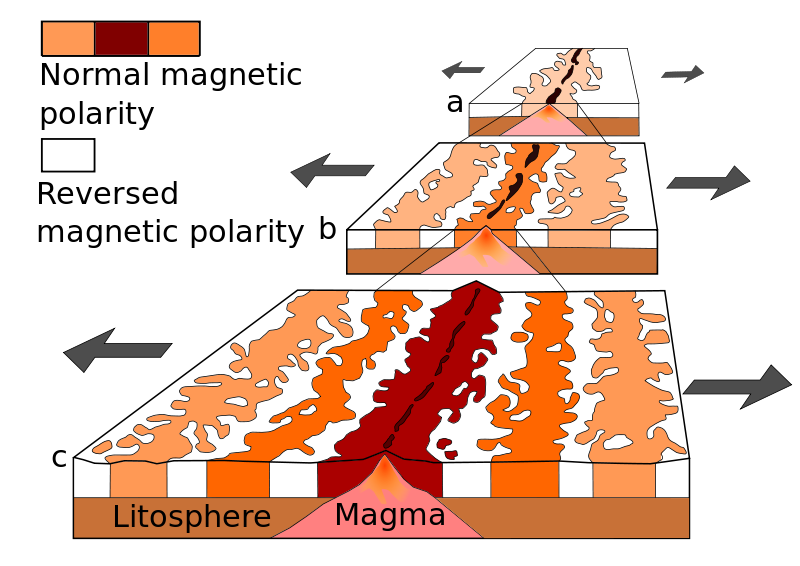
Figure 20. Seafloor magnetic striping
Start in the 1950s, scientists like Victor Vacquier, using magnetic instruments (magnetometers) adapted from airborne devices adult during Earth War II to detect submarines, began recognizing odd magnetic variations across the body of water floor. This finding, though unexpected, was not entirely surprising because information technology was known that basalt—the iron-rich, volcanic rock making upward the bounding main floor—contains a strongly magnetic mineral (magnetite) and tin can locally distort compass readings. This distortion was recognized by Icelandic mariners as early as the tardily eighteenth century. More important, because the presence of magnetite gives the basalt measurable magnetic backdrop, these newly discovered magnetic variations provided another ways to study the deep bounding main floor. When newly formed rock cools, such magnetic materials recorded the World'due south magnetic field at the time.
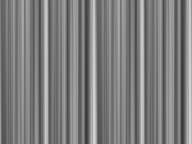
Figure 21. A sit-in of magnetic striping. (The darker the colour is, the closer it is to normal polarity)
As more than and more of the seafloor was mapped during the 1950s, the magnetic variations turned out not to exist random or isolated occurrences, but instead revealed recognizable patterns. When these magnetic patterns were mapped over a wide region, the ocean floor showed a zebra-like blueprint: ane stripe with normal polarity and the adjoining stripe with reversed polarity. The overall design, defined by these alternating bands of normally and reversely polarized stone, became known as magnetic striping, and was published past Ron Yard. Mason and co-workers in 1961, who did not find, though, an explanation for these information in terms of sea flooring spreading, like Vine, Matthews and Morley a few years later.
The discovery of magnetic striping called for an explanation. In the early on 1960s scientists such every bit Heezen, Hess and Dietz had begun to theorise that mid-sea ridges marker structurally weak zones where the ocean floor was being ripped in two lengthwise along the ridge crest (meet the previous paragraph). New magma from deep within the Earth rises easily through these weak zones and somewhen erupts forth the crest of the ridges to create new oceanic chaff. This process, at showtime denominated the "conveyer belt hypothesis" and later on chosen seafloor spreading, operating over many millions of years continues to form new ocean floor all across the 50,000 km-long system of mid-ocean ridges.
Only four years after the maps with the "zebra design" of magnetic stripes were published, the link between body of water floor spreading and these patterns was correctly placed, independently by Lawrence Morley, and by Fred Vine and Drummond Matthews, in 1963, now called the Vine-Matthews-Morley hypothesis. This hypothesis linked these patterns to geomagnetic reversals and was supported past several lines of evidence:
- the stripes are symmetrical around the crests of the mid-bounding main ridges; at or most the crest of the ridge, the rocks are very young, and they get progressively older away from the ridge crest;
- the youngest rocks at the ridge crest always have present-day (normal) polarity;
- stripes of rock parallel to the ridge crest alternate in magnetic polarity (normal-reversed-normal, etc.), suggesting that they were formed during different epochs documenting the (already known from independent studies) normal and reversal episodes of the Earth'due south magnetic field.
By explaining both the zebra-like magnetic striping and the construction of the mid-ocean ridge system, the seafloor spreading hypothesis (SFS) quickly gained converts and represented another major advance in the development of the plate-tectonics theory. Furthermore, the oceanic crust now came to be appreciated as a natural "record recording" of the history of the geomagnetic field reversals (GMFR) of the Earth'due south magnetic field. Today, extensive studies are dedicated to the scale of the normal-reversal patterns in the oceanic crust on 1 manus and known timescales derived from the dating of basalt layers in sedimentary sequences (magnetostratigraphy) on the other, to arrive at estimates of past spreading rates and plate reconstructions.
Definition and Refining of the Theory
After all these considerations, Plate Tectonics (or, as it was initially called "New Global Tectonics") became quickly accepted in the scientific world, and numerous papers followed that divers the concepts:
- In 1965, Tuzo Wilson who had been a promotor of the body of water floor spreading hypothesis and continental drift from the very beginning added the concept of transform faults to the model, completing the classes of fault types necessary to make the mobility of the plates on the globe work out.
- A symposium on continental drift was held at the Purple Society of London in 1965 which must be regarded every bit the official start of the acceptance of plate tectonics by the scientific community, and which abstracts are issued equally Blacket, Bullard & Runcorn (1965). In this symposium, Edward Bullard and co-workers showed with a computer adding how the continents forth both sides of the Atlantic would best fit to close the body of water, which became known as the famous "Bullard's Fit".
- In 1966 Wilson published the paper that referred to previous plate tectonic reconstructions, introducing the concept of what is now known equally the "Wilson Cycle."
- In 1967, at the American Geophysical Spousal relationship'due south meeting, W. Jason Morgan proposed that the Earth'south surface consists of 12 rigid plates that motility relative to each other.
- 2 months later on, Xavier Le Pichon published a complete model based on 6 major plates with their relative motions, which marked the concluding credence by the scientific community of plate tectonics.
- In the same year, McKenzie and Parker independently presented a model like to Morgan's using translations and rotations on a sphere to define the plate motions.
Cheque Your Understanding
Answer the question(s) below to see how well you understand the topics covered in the previous section. This short quiz doesnot count toward your grade in the class, and you can retake it an unlimited number of times.
Use this quiz to bank check your understanding and decide whether to (1) study the previous section further or (2) move on to the next department.
Source: https://courses.lumenlearning.com/wmopen-geology/chapter/outcome-theory-of-plate-tectonics/
0 Response to "What force is powerful enough to move plates on Earths Surface?"
Post a Comment